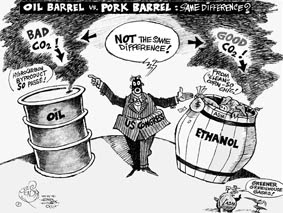By Bill Frezza
We are not the first to wonder. The 19th century
French economist Frédéric Bastiat asked and answered that question in 1849,
stating that money was a promise to “Pay the bearer a service equivalent to
what he has rendered to society.” Note the past tense — a product or service
must be rendered before money can properly come into existence.
Just as importantly, Bastiat recognized that equivalence
was not fixed or even defined. Instead, it is up to the knowledge and judgment
of each individual every time he or she engages in voluntary exchange. This
freedom creates the information content that is known as a “price.” It is also
how economies learn to effectively allocate resources and promote growth. Adam
Smith dubbed it the “Invisible Hand.”
Wealth, or capital, is simply deferred consumption
that is put to work. When done wisely, wealth multiplies, leaving more to
consume tomorrow.
Money’s unredeemed promise might be tokenized by a
paper note, a gold coin, or a few bits in a computer database. Every form of
tokenization has its strengths and weaknesses. History demonstrates that the
soundness of the token is directly proportional to the difficulty of its
creation, as this helps ensure stability of the money supply.
The moral claim real money places on society on behalf
of its bearer comes not from the intrinsic value of the token but from the fact
that the bearer had previously produced some good or service deemed valuable by
others. This is what gives money its moral legitimacy.
Western Civilization has forgotten this, and we are
all paying the price.
Ironically, the inventors of democracy may be the
first to rediscover the moral foundations of money, as barter networks begin
springing up across a demonetized Greece. Hundreds of them are now in
operation, many in anticipation of the shock to come when Greece is inevitably
forced to say goodbye to the euro. These networks are lubricating commerce just
as jobs and euros in the formal economy are running dry.
Members of barter clubs receive Local Alternative
Units, or TEMs for their Greek acronym, in return for some product or service
rendered to another member of the closed community. Fellow community members
agree to redeem these TEMs in kind, and are cast out if they don’t. While it
sounds primitive, and it is, TEMs are real money.
Through the use of TEMs, Greeks are becoming
reacquainted with the moral foundations of money. “The most exciting thing you
feel when you start is this sense of contribution,” a participant reports in a
recent news story. “You have much more than your bank account says. You have
your mind and your hands.”
Compare this to government fiat currency, which has
largely displaced real money. Manufactured on the whim of unaccountable
officials and rooted in government debt rather than private assets, fiat money
is circulated, pyramid-like, through a fractional reserve banking system until
its connection to reality is entirely severed.
Modern fiat currency fuels the growth of both
government and the financial sector because it is not a promise to repay that
which has been produced. Rather, it is a threat to squeeze the taxpayers of the
future, including the yet unborn. And because the tokens can be manufactured at
will, governments can harness the power of inflation to pay off their debts in
coin that is worth less than the currency in which those debts were incurred.
Those near the source of modern money creation are expert
at its manipulation, weaving it into complex financial instruments that
function more like casino chips than real money. Wealth accumulated under this system is not
capital at all, but rather a pile of IOUs, the sum total of which can never be
redeemed. When too many customers try to redeem these IOUs at the same time,
financial institutions fail—unless these institutions are bailed out by
governments, propped up with more IOUs. This can cascade until too many people
try to redeem those IOUs, at which point governments begin to fail.
Which brings us back to Greece.
While more extreme in magnitude, what is going in
Greece today is also going on throughout the Western world. Lined up like
dominoes are other governments whose accumulated IOUs vastly exceed their
ability to bully taxpayers into making good on them. Governments that squeeze
producers and consumers too hard soon learn that growth suffers, making
anticipated tax revenue evaporate before it is even collected.
It doesn’t have to be this way. But if we don’t learn
from Greece’s mistakes we will surely repeat them. Let’s hope the rest of us
rediscover the moral foundations of money before we are forced to experience
barter clubs firsthand.
